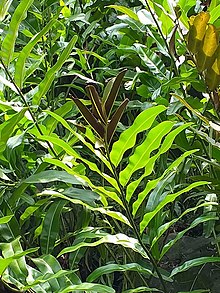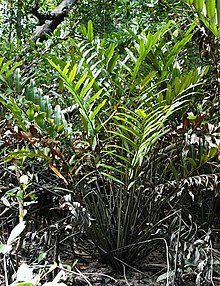en
names in breadcrumbs


Acrostichum aureum, the golden leather fern, is a large species of fern that grows in mangrove swamps and other wet locations. Other common names include swamp fern and mangrove fern.
The golden leather fern has large fronds growing to a length of 1.8 metres (six feet). The leaves are glossy, broad and pinnate, the pinnae being dark green, leathery, alternate and widely spaced. The outer fronds arch over sideways but the central ones are nearly straight. Some of the larger fronds bear sporangia (reproductive organs) on the upper five to eight pairs of pinnae. These are brick red and give the pinnae a felted appearance.[2]
The golden leather fern is found in tropical and sub-tropical areas around the world. It grows in swamps and mangrove forests, salt marshes and on river banks and is tolerant of raised salinity levels. The spores germinate better, however, in fresh water. It tends to grow on slight elevations in the mangrove swamp in areas which are inundated by the sea occasionally. It can also grow in freshwater locations. In Malaysia there are two plant forms. The larger ones occur on the periphery of the swamp where they may reach 4 metres (13 ft) while much more stunted plants grow in the areas which are frequently inundated. It can grow in full sun or in deep shade and it has been found that the mangrove Rhizophora mucronata can regenerate in dense stands of the fern.[2]
The IUCN Red List of Threatened Species lists the golden leather fern as being of "Least Concern"" because it is common, is fast growing, regenerates easily and has few threats. It grows vigorously in disturbed areas of mangrove forest and may be difficult to eradicate.[1]
In Cambodia, where the fern is known as prâng' tük (prâng'="cycad", tük="aquatic", Khmer language), the young leaves are eaten in salads.[3]
In the Indian state of Goa the fern is consumed cooked in a spicy coconut based gravy known as tonak. It is considered a delicacy by the local people.
Golden leather fern can be grown under high light in garden soil or potting mix, if the substrate is kept constantly wet. Ordinary fresh water (not brackish water) is sufficient for cultivation.[4]
 Sporophylls
Sporophylls Acrostichum aureum, the golden leather fern, is a large species of fern that grows in mangrove swamps and other wet locations. Other common names include swamp fern and mangrove fern.
Paku laut adalah sejenis paku-pakuan berukuran besar, yang biasa tumbuh di tanah di bawah naungan hutan bakau atau lahan basah lainnya. Paku atau pakis ini juga dikenal dengan banyak nama lain seperti paku larat, papah, piai (Mal.: piai raya), paku hata diuk (Sd.), warakas, krakas, kakakeok (Jw.), rewayang (Hal.) dan lain-lain.[1] Nama-namanya dalam bahasa Inggris di antaranya golden leather fern, swamp fern, dan mangrove fern.
Paku dalam rumpun yang besar, dapat mencapai tinggi 4 m, dan lebar rumpun yang kurang lebih sama. Batang pendek dan kekar, tegak, tertutupi oleh sisik-sisik besar kecoklatan.
Daun-daun majemuk menyirip, liat serupa kulit (jangat), panjangnya dapat mencapai 3 m, tetapi dengan tak lebih dari 30 pasang anak daun yang terletak tak beraturan dan, kadang-kadang, renggang. Beberapa pasang (5 pasang atau lebih) anak daun di ujung kerap fertil dan berwarna karat atau kecoklatan, dengan sisi bawah yang tertutupi oleh banyak sporangia yang besar-besar. Anak-anak daun yang steril (mandul) berada di bagian bawah, lebih panjang dan berujung tumpul atau membulat, serta dengan tonjolan ujung kecil yang pendek.[2]
Tumbuh menahun, paku laut hidup di lingkungan hutan bakau (mangrove), rawa pantai, tambak, serta di sepanjang sungai, parit dan kanal dekat laut. Meski demikian, Acrostichum aureum tak seberapa tahan oleh penggenangan pasang air laut dan tak menyukai tanah-tanah dengan salinitas tinggi; tak sebagaimana kerabat dekatnya, A. speciosum.[2]
Meski bersifat halofit (halophytic), paku laut membutuhkan pasokan air tawar yang cukup agar dapat tumbuh optimal. Di tempat-tempat di mana frekuensi penggenangan pasang laut cukup tinggi (10-28 kali perbulan), pakis ini tumbuh kerdil atau bahkan sama sekali tak mau tumbuh. Terhadap penyinaran matahari, paku ini dapat mentolerir pelbagai kondisi seperti tumbuh di bawah naungan hingga ke tempat-tempat terbuka yang terik.[3] Bahkan, paku ini dapat menginvasi lahan-lahan bekas tebangan dan membentuk padang paku laut yang cukup luas.
Daun-daun paku laut yang dikeringkan dipergunakan sebagai atap rumah. Pucuknya yang muda juga dimanfaatkan sebagai sayuran di beberapa daerah.[1] Daun-daun yang tua dan juga akarnya digunakan sebagai bahan obat tradisional.[2]
Acrostichum aureum ditemukan menyebar di wilayah-wilayah tropis dan ugahari di seluruh dunia, termasuk di Indonesia.
Acrostichum speciosum memiliki perawakan yang mirip dengan A. aureum, dengan sedikit perbedaan. Anak-anak daun yang steril pada A. speciosum memiliki ujung yang meruncing, tak seperti A. aureum yang berujung tumpul atau membulat.[2] (Lihat pula foto pada laman Piai raya, pada Guide of the Mangroves of Singapore).
A. speciosum ditemukan pada habitat yang serupa dengan A. aureum di Nusantara, tetapi umumnya lebih menyukai tempat-tempat yang kelindungan.[2]
Acrostichum danaefolium serupa pula bentuknya dengan A. aureum. Hanya saja anak daun yang fertil –dengan sporangia di sisi bawahnya– tidak terbatas pada pasangan anak-anak daun di ujung, melainkan juga hingga pasangan-pasangan dekat pangkal daun.[4] A. danaefolium tidak terdapat di Nusantara.
Paku laut adalah sejenis paku-pakuan berukuran besar, yang biasa tumbuh di tanah di bawah naungan hutan bakau atau lahan basah lainnya. Paku atau pakis ini juga dikenal dengan banyak nama lain seperti paku larat, papah, piai (Mal.: piai raya), paku hata diuk (Sd.), warakas, krakas, kakakeok (Jw.), rewayang (Hal.) dan lain-lain. Nama-namanya dalam bahasa Inggris di antaranya golden leather fern, swamp fern, dan mangrove fern.
Acrostichum aureum L., 1753 è una felce della famiglia delle Pteridaceae[2].
È una felce di notevoli dimensioni, che può raggiungere i 3 m di altezza.[3] Ha fronde composte da 24-30 pinne, erette, lunghe da 1 a 4 m, sorrette da un lungo picciolo. Le 5-8 paia di pinne apicali portano sulla loro lamina inferiore gli sporangi, di colore rosso-brunastro.
La specie ha una distribuzione molto ampia, essendo presente nelle formazioni di mangrovia dei Caraibi, dell'Africa, dell'Asia e dell'Oceania.[1]
Acrostichum aureum L., 1753 è una felce della famiglia delle Pteridaceae.
Ráng đại, tên khoa học Acrostichum aureum,[2] là một loài thực vật có mạch trong họ Pteridaceae. Loài này được L. miêu tả khoa học đầu tiên năm 1753.[3]
Ráng đại, tên khoa học Acrostichum aureum, là một loài thực vật có mạch trong họ Pteridaceae. Loài này được L. miêu tả khoa học đầu tiên năm 1753.
卤蕨(学名:Acrostichum aureum)为卤蕨科卤蕨属下的一个种。
|access-date=中的日期值 (帮助)
 分類 界 : 植物界 Plantae 門 : シダ植物門 Pteridophyta 綱 : シダ綱 Pteridopsida 科 : イノモトソウ科 Pteridaceae 属 : ミミモチシダ属 Acrostichum 種 : ミミモチシダ Acrostichum aureum
分類 界 : 植物界 Plantae 門 : シダ植物門 Pteridophyta 綱 : シダ綱 Pteridopsida 科 : イノモトソウ科 Pteridaceae 属 : ミミモチシダ属 Acrostichum 種 : ミミモチシダ Acrostichum aureum ミミモチシダは、熱帯系のシダ植物の一つ。大きな小葉を持つ大柄なシダで、マングローブの湿地に生育する。
ミミモチシダ Acrostichum aureum L. は、イノモトソウ科ミミモチシダ属の多年生草本である。
根茎は塊状で、大きな鱗片がつく。葉は立ち上がり、高さは3mにも達するという。葉柄は1mになることもあるが、葉全体の中では多くを占めない。葉身は単羽状複葉で、あまり長さの変わらない細長い小判形の裂片を多数並べた形、全体としては挟長楕円形となる。裂片には短いがはっきりした柄があり、長さ30-50cm、幅は4-8cmになる。葉は全体に硬く、葉身も革質で、むしろ熱帯系の葉の広いソテツ類にも似ている。
胞子嚢群は葉身の先端側の裂片に生じ、その裏面全体につく。
一般に、丸く突出した部分がある場合にこれを耳状という。たとえば葉の基部、いわゆる葉脚が丸く突出している場合などにこれを耳状と言うなどの例があるが、この種にはそのようなものが全くない。
どうやら学名の誤読に由来するらしく、種小名の aureum は、「黄金色の」の意味で、これは胞子嚢群が一面についた葉裏が、若いときに黄色を帯びることに基づくものだが、これを auriculatumu 「耳片のある」と誤読したことによるという。
湿地に生える。普通はマングローブ林の湿地に大きな群落を作る。根元はごく湿った泥の中にあり、往々に水に浸っている。マングローブを生育地とする唯一のシダ植物とも言われる。マングローブ後方の湿地に出ることもある。
世界の熱帯域に広く見られる。日本では琉球列島八重山諸島の石垣島、西表島と与那国島にある。ただし台湾には見られない。
この属には他に世界に3種ほどがあるが、日本ではこの種のみが知られる。この大きさと姿に間違うようなものは他にはない。
実質的な利用例はない。
日本ではその分布域がごく少なく、熱帯系の特異な植物であることから保護を受けている。ただしその生育地が山間奥地ではなく、平地にあるため、開発の影響を非常に受けやすい。石垣では名蔵アンパルに群落が見つかっている。西表島では数カ所の生育地があり、星立の群落が国指定の天然記念物に指定されている。与那国島では久部良ミトゥ湿地の群落が町の天然記念物に指定されている。いずれも生育面積は狭いが、生育の状況はよい。山と渓谷社の『レッドデータプランツ』では、育ちすぎて刈り取られるくらい、などととてもRDB植物に対する物言いとは思えないような書かれ方がされているほどである。
西表島のある生育地はこの島の周遊道路に隣接しており、簡単にその姿を観察することができる。草が深くサキシマハブが潜んでいる可能性もある為、手で触れるほど近づくのは難しい。同島では農地とほぼ隣接して生育しているところもあり、その排水工事などの影響によって乾燥化が懸念されるなどといった論議もある。